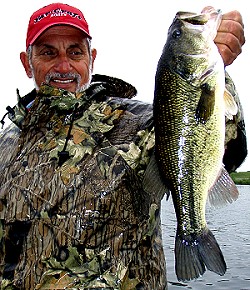 With an increasing number of anglers learning how to find the best spots in a body of water, the little things you do while fishing can mean a lot. Technique is becoming increasingly important.The first two bass fighting ventures of the year produced 31 bass, 29 of which I caught. The major reason? I was using the new thin, no-stretch braided lines. Both early-spring days were windy and the thinner line cut the wind to give me less line bow plus greater overall feel. With an increasing number of anglers learning how to find the best spots in a body of water, the little things you do while fishing can mean a lot. Technique is becoming increasingly important.The first two bass fighting ventures of the year produced 31 bass, 29 of which I caught. The major reason? I was using the new thin, no-stretch braided lines. Both early-spring days were windy and the thinner line cut the wind to give me less line bow plus greater overall feel.
On the first trip, the bass were smacking lipless, vibrating crank baits run just across the top of newly emerging weed-beds. I was able to feel the slightest weed contact and keep the lure from plowing down into the vegetation, something my partner using monofilament was unable to do.
The second outing found bass holding in some low, deep grass outside a weed-bed. Single-spin spinner bait slowly pumped through the area proved to be the presentation answer, but my partner’s stretchy mono didn’t telegraph the proper messages. In both instances a 3 to 4 foot monofilament leader was used to connect the lure to the braided line via a blood know. (This isn’t a “braided-line commercial,” because I still prefer mono most of the time.)
Two early season pike expeditions were highly dependent on technique. During one, pike were observed in shallow, early-to-warm bays slowly cruising or holding on bottom like unconcerned logs. The normal array of “killer pike lures” wouldn’t turn a head, as various anglers would cast awhile, then leave in disgust when the bigger fish wouldn’t bite.
I knew this was “Slug-Go time” and rigged a 6- inch jerk work behind a short wire leader. Letting the lure slowly sink to the bottom, then working in painfully slow with slight twitches, turned the trick. Following pike could usually be teased into hitting by an even slower retrieve sprinkled with short hops that k i8cked up small puffs of silty bottom. Their big white lined mouths opened and inhaled the slow falling work, often with in a few feet of the boat.
One of the most striking examples of technique came last June while pike fishing a shallow, dark-water bay just before dark. My partner and I had been catching some pike but no real tackle-busters. I had an impulsive thought that a top water lure might work but hasn’t brought any. Noticing a bass-size, double-propped, thin-profile plug in my companion’s open tackle box, I suggested he give it a try. After making a half-dozen casts using a pull-pause, pull-pause retrieve that activated the water-churning props to make a whirling sound, he made a few more casts using a fairly slow straight retrieve. The blade hummed softly, gently spraying water a few inches above the surface. No takers – the lure was put back.
Even though small prop-baits were not on my “deadly big pike lure list,” I had a feeling. “Can I borrow that lure?” I asked. He politely handed it over.
On my first cast a 20 pounder sucked in the 3/8 ounce lure. Six casts later a pike nearly 27 pounds engulfed the diminutive offering – both fish caught out of the same area we had been fishing!
Pete sheepishly turned to me and softly asked if he could burrow his lure back. I would not have cast it anymore. His first effort carried long and the retrieve began. The whirling of the blades could be heard as the lure came toward the boat. Suddenly it dawned on me – I hadn’t heard the lure make any noise when I was retrieving it. “Put your rod tip down,” I suggested. My partner quickly lowered his rod tip, the humming sound ended and a pike well over 20 pounds sucked in the lure.
The difference? A high-held rod tip caused a loud whirling noise that didn’t attract these early-season pike. A low tip kept the lure’s nose down and the blades quietly humped up the surface like a slow-swimming, easy meal.
A few years ago, Field Editor Joe Bucher and I were fishing for early-season crappies. Our dime-size floats held small minnows right in front of crappies we could see in the shallow, cold water. We both used 4-pound test line and small hooks, yet Joe was catching four crappies to my one. The difference? I used a tiny split shot halfway between float and hook. Joe went weightless. I knew what he was doing and wouldn’t change. I just didn’t believe something that small could make a difference. But it did – Little things can mean a lot.
For more great fishing information please feel free to visit Spence at www.spencepetros.com. |